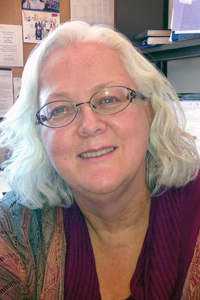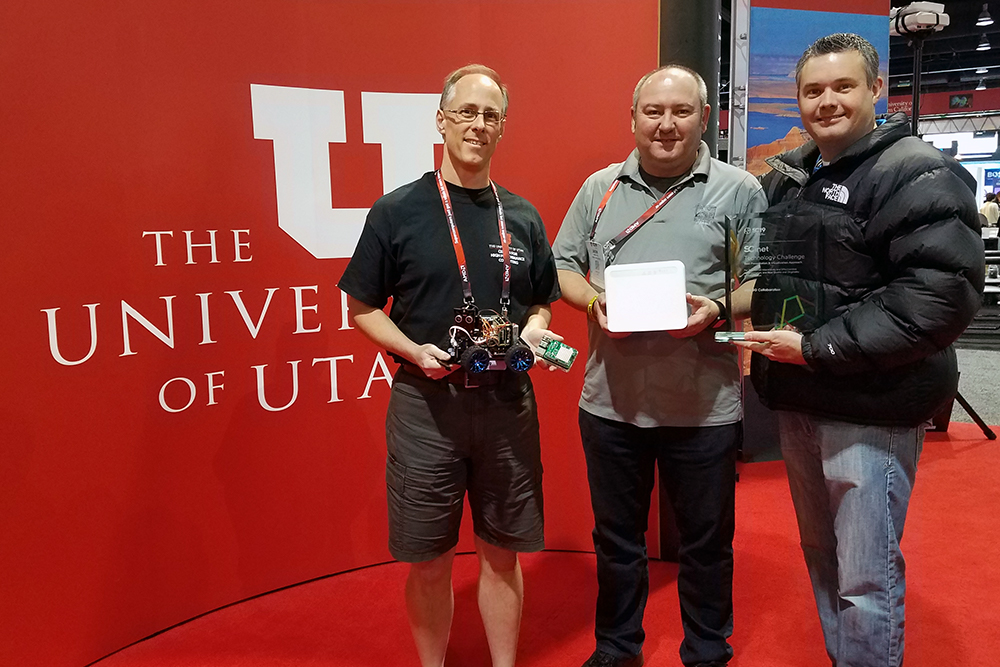You’re accessing archived content
This is archived content from the UIT website. Information may be outdated, and links may no longer function. Please contact stratcomm@it.utah.edu if you have any questions about archived content.

SC19 attendees gather to take photos and view panels with details about previous conferences. (Courtesy of SC Photography)
CHPC reaches SC conference milestone, wins award with Murray schools

Anita Orendt, assistant director for Research Consulting and Faculty Engagement, Center for High Performance Computing
By Anita Orendt, assistant director for Research Consulting and Faculty Engagement, Center for High Performance Computing
The Center for High Performance Computing (CHPC) once again hosted an exhibition booth at the annual Supercomputing Conference, celebrating a milestone 20 years at the international symposium for high performance computing, networking, storage, and analysis.
Sponsored by the Association for Computing Machinery and the IEEE Computer Society, the convention was first held in 1988. CHPC has attended most of the 31 years and hosted a booth every year since 1999.
The theme of ’this year’s conference, held November 16-22, 2019 in Denver, Colorado, was “HPC is NOW.” There were 13,950 attendees, breaking last year’s record of 13,071 attendees, and 370 exhibitors, with 66 first-time exhibitors. Along with the exhibition floor, SC19 included presentations, tutorials, workshops, birds-of-a-feather meetings, a student cluster competition, and a multitrack technical program on high performance computing (HPC) research.
As in years past, CHPC reached out to our user community for content so we could highlight research completed with the assistance of CHPC resources. Using a slideshow of posters, images, and movies, our booth demonstrated the science behind the research.
This year, CHPC and Murray City School District, with support from the Utah Education and Telehealth Network (UETN), participated in the first SCinet Technology Challenge. The goal of the challenge, according to SC19’s website, “is to demonstrate that both networking and HPC resources are essential elements of the cyber infrastructure required to advance modern data-driven scientific applications.”

CHPC's booth highlighted research done with the help of CHPC resources. (Courtesy of SC Photography)
For the past couple of years, Murray has been exploring the use of cellular technologies deployed in the Citizens Broadband Radio Service (CBRS) spectrum (3550MHz to 3700MHz). This new spectrum allocation by the FCC has allowed Murray to roll out its own private cellular infrastructure in order to explore how to deal with Wi-Fi congestion and reach students who might not have internet service at home. Murray is the first K-12 entity in the nation to attempt this exploration.

CHPC's Joe Breen, from left, and Murray City School District's Jason Eyre and Kraig Fisher won the Best Presentation & Visualization Approach award in the SCinet Technology Challenge. (Courtesy of Anita Orendt)
CHPC collaborated with Murray to characterize the network and to demonstrate how science applications could utilize the service. With the work of several sUdo (Student University Development Opportunity) program students, CHPC built and provided visualization of network and environmental sensors that utilized the deployed CBRS network. These sensors modeled a typical science application, and attempted to show data collection and real-time control capabilities. The SCinet Technology Challenge jury rewarded the hard work and long hours CHPC and Murray put into the project with the Best Presentation & Visualization Approach award.
In addition, one of the two sUdo interns who developed Arbiter for CHPC presented a lightning talk on the service at the HPC Systems Professionals Workshop (HPCSYSPROS). Arbiter enforces policy limits on the usage of the cluster login or interactive nodes by dynamically limiting usage at a user level. As these nodes are the gateway for working on the clusters, it is essential that they are responsive, as not to impact the ability of all users to work on CHPC resources.
The SC conference series provides a unique opportunity for face-to-face meetings between CHPC and peers from other academic research computing facilities to discuss common practices and issues, as well as the ability to interact with various HPC communities, such as ’XSEDE’s Campus Champions, HPCSYSPROS, Campus Research Computing Consortium (CaRCC), and the Rocky Mountain Advanced Computing Consortium (RMACC). The conference also allows for meetings with HPC vendors to explore emerging IT and cyberinfrastructure capabilities.
In addition to CHPC's involvement, UETN contributed to and participated in SCinet, which is a volunteer effort that plans, builds, and operates the conference network. This year, SCinet had about 200 volunteers — including Stacy Vincent from the Governance, Regulation & Compliance team in the Information Security Office — and 35 contributors providing more than $80 million of hardware, software, and services. SCinet installed 67 miles of fiber and delivered 4.22 terabits per second capacity.
University of Utah faculty and students also presented posters, papers, research talks, and participated on panels.
CHPC looks forward to continuing its participation in this conference by again hosting a booth at SC20, to be held November 15-20, 2020 in Atlanta, Georgia.
Node 4
Our monthly newsletter includes news from UIT and other campus/ University of Utah Health IT organizations, features about UIT employees, IT governance news, and various announcements and updates.
